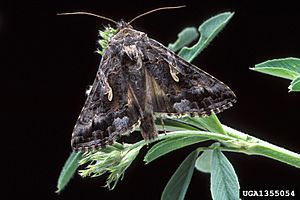Alfalfa looper facts for kids
Quick facts for kids Alfalfa looper |
|
|---|---|
 |
|
| Scientific classification |
The alfalfa looper (scientific name: Autographa californica) is a type of moth. It belongs to a family of moths called Noctuidae. A scientist named Adolph Speyer first described this moth in 1875.
You can find the alfalfa looper in western North America. Its range goes from southern British Columbia down to Baja California. It also reaches places like Manitoba, South Dakota, Colorado, and New Mexico.
About the Alfalfa Looper
This moth has a wingspan of about 36 to 42 millimeters. That's roughly the length of a small paperclip! You can see these moths flying from July to October. The exact time depends on where they live.
What do Alfalfa Looper Caterpillars Eat?
The young moths, called larvae or caterpillars, eat many different kinds of plants. They are not picky eaters! Their diet includes plants from various families.
Some of the plant families they are known to eat are:
- Apiaceae (like carrots and parsley)
- Aquifoliaceae (like holly plants)
- Asteraceae (like sunflowers and daisies)
- Boraginaceae (like borage)
- Brassicaceae (like cabbage and broccoli)
- Caprifoliaceae (like honeysuckle)
- Chenopodiaceae (like spinach and beets)
- Cucurbitaceae (like pumpkins and cucumbers)
- Ericaceae (like blueberries)
- Fabaceae (like beans and peas)
- Grossulariaceae (like currants)
- Liliaceae (like lilies)
- Lamiaceae (like mint)
- Linaceae (like flax)
- Malvaceae (like mallow)
- Plantaginaceae (like plantain)
- Poaceae (like grasses)
- Podocarpaceae (a type of conifer)
- Polygonaceae (like buckwheat)
- Rhamnaceae (like buckthorn)
- Rosaceae (like roses and apples)
- Rutaceae (like citrus fruits)
- Scrophulariaceae (like figworts)
- Solanaceae (like potatoes and tomatoes)
- Verbenaceae (like verbena)
Images for kids


